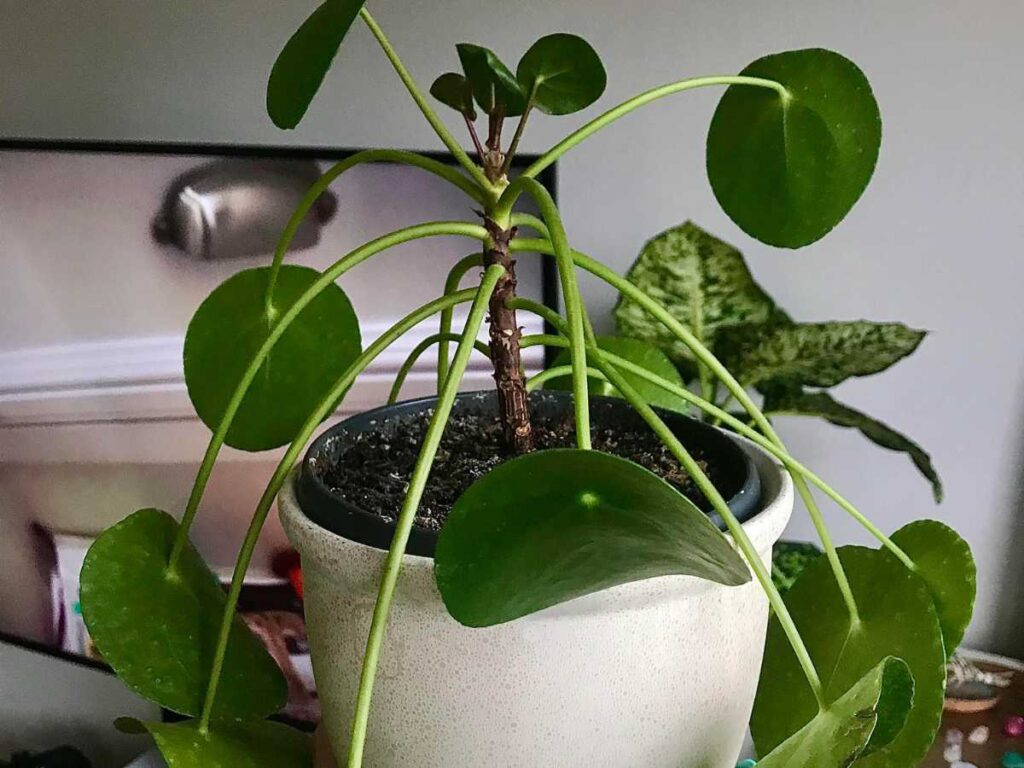“Money doesn’t grow on trees,” or so they say. But the Chinese money plant (Pilea peperomioides) – also known as a pancake plant, lefse plant, missionary plant, or UFO plant – might make you think otherwise!
This easy-care houseplant, with its round leaves and bright green color, is often seen adorning windowsills and desks in homes around the world.
Unfortunately for many owners of this famous foliage beauty, their beloved plants have begun to drop leaves. So what’s causing these leafy casualties?
In this article, we’ll discuss why your Chinese money plant may be dropping its leaves and how to best care for it to ensure you can continue enjoying its lush greenery for years to come.
Here’s Why Is Your Chinese Money Plant Dropping Its Leaves?
Chinese money plants (Pilea peperomioides) can drop their leaves due to unsatisfactory growing conditions such as overwatering, poor drainage, temperature fluctuations, low humidity, and inadequate or too-bright light. Additionally, a lack of nutrients in the soil can lead to leaf drop.

What Is a Chinese Money Plant?
The scientific name for the Chinese Money Plant is Pilea peperomioides. Its leaves are usually round with scalloped edges, and its stems create an architectural pattern when grown together.
This type of plant enjoys bright but indirect light and loves humidity – if kept dry, it can drop some of its leaves! So, in terms of watering needs, make sure to keep your soil moist but not soggy.
This unique houseplant looks great on shelves or tables as part of a stylish home decor display. However, the Chinese Money Plant’s beauty doesn’t stop at its visual appeal; apparently, it also brings good luck into your life too!
Whether that be true or not, we can agree that it’s definitely worth having around, even if just for aesthetic purposes alone.
What Causes Chinese Money Plants to Drop Leaves?
It can be pretty disheartening to see the leaves of your Chinese money plant drooping and dropping off. But before rushing out for a replacement, it’s important to understand why this is happening in the first place.
Let’s explore what causes Chinese money plants to drop their leaves so that you can take appropriate steps toward reviving them!
One common issue with Chinese money plants is low humidity. These plants thrive best when surrounded by warm air that has good moisture content. So if there isn’t enough humidity in their environment, they will start losing their leaves as an indication of distress.
Another possible cause could be overwatering or underwatering; too much water can lead to root rot. On the other hand, not watering the soil sufficiently might result in dryness and wilting of the foliage.
Finally, another reason behind leaf shedding could be exposed to cold temperatures below 50°F (10°C). This significantly impacts photosynthesis and disrupts growth, resulting in yellowed and falling leaves on your beautiful houseplant.
Knowing these potential causes makes it easier for us to identify any underlying issues our beloved Chinese money plant may have and help them grow back strong and healthy again!
How to Identify if A Chinese Money Plant Is Dropping Leaves
Identifying the cause of why your beloved plant’s dropping leaves is easier than it seems. Let’s look at how we can figure out what’s going on so that our plants can regain their health.
First off, some common signs will help us identify why this could be happening:
- Too much or too little water: If the soil is either overly wet or very dry, then this could lead to a leaf drop.
- Exposure to direct sunlight for extended periods: Even though these plants love light, too much exposure can end up burning them and cause leaf-drop.
- Over fertilization: Excess fertilizer causes an imbalance in nutrient levels, affecting photosynthesis, leading to yellowing and eventually leaf-drop.
- Lack of humidity: Money plants enjoy humid conditions, so if they need more moisture from misting or other methods, they’ll start losing their foliage.
Once you’ve identified any potential issues, it’s essential to act fast by providing the proper care tailored specifically for your plant according to its needs – watering more frequently, adjusting lighting times, etcetera – all crucial steps towards helping your plant recover its glory days!
However, sometimes even after trying everything possible, things don’t work out, and sadly, it has come down to age being a factor; since Chinese money plants usually live between two and four years before needing repotting due to overcrowded roots or simply natural aging.
Whatever the case may be, investing in understanding the nature of your particular specimen goes a long way in ensuring optimal growth for many seasons ahead!
It might feel daunting having gone through this list only to find yourself still unsure about what’s causing your plant’s suffering; however, taking small steps towards learning all aspects related to caring for this species pays off immensely over time.
As gardeners, we must remember that nothing stays the same forever and therefore always strive towards adapting new practices while keeping an open mind ready for whatever challenges Mother Nature brings our way!
How to Diagnose Causes of Chinese Money Plant Leaf Drop
First, assess the environment around your Chinese money plant. Is there enough light? Too much water? Not enough fertilizer? Temperature too hot or cold? These environmental factors all play an important role in determining if a leaf drop is due to something external.
Additionally, look for signs of pests such as aphids or mealybugs that could have caused damage to the foliage.
Next, check the soil quality and nutrition levels. For example, determine if the soil is too alkaline or acidic, which will influence how well plants take up nutrients from their surroundings.
If possible, test the pH level of your soil and adjust accordingly to ensure optimal uptake of macro-nutrients such as nitrogen, phosphorus, and potassium.
Finally, consider if any mechanical trauma has occurred recently, such as being moved too frequently or having its branches pruned incorrectly – this could also cause distress on your Chinese money plant leading to leaf drop.
By considering these steps when diagnosing your Chinese money plant’s condition, you’ll find yourself one step closer to providing it with everything it needs to flourish again. Make sure to observe closely over time so you can catch issues before they become serious problems!
Ways To Prevent Chinese Money Plants From Dropping Leaves
Preventing Chinese money plant leaves from dropping is like trying to hold on to a handful of slippery eels. It can be tricky, but with the right approach, it’s doable!
To start, ensure your potting soil has proper drainage and you’re not overwatering your plant. If there are no air pockets in the soil, then water won’t be able to evaporate correctly, leading to root rot which will cause leaf drop.
Secondly, check for any pests or diseases that could be attacking the leaves – if you spot anything like this, treat it quickly before it worsens.
Finally, ensure your plants get enough light by positioning them near windows or using artificial lighting. This helps promote photosynthesis so they can create energy and stay healthy.
Planting your Chinese money plant correctly, regularly checking for disease/pests, and providing adequate light are all important steps in preventing leaf drop. With these three simple tips, you’ll have a beautiful Chinese money plant thriving in no time!
Troubleshooting Frequent Chinese Money Plant Leaf Drop
Troubleshooting frequent leaf drops can be tricky – but it doesn’t have to be overwhelming. Instead, knowing a few key points of prevention and care will help you keep your precious plant healthy and thriving for years.
First, start by assessing the environment that your plant is in. For example, is it kept in direct sunlight or away from windowsills where too much light could reach it?
Also, check if the temperature around the plant is consistent – low temperatures are known to trigger leaf drop, so make sure there are no drafts nearby!
Finally, consider how often you water your plant; overwatering can cause root rot, leading to leaf drop.
Once you’ve determined what may be causing the problem, taking steps to remedy the situation should follow suit. If the location could be better, consider moving it somewhere more suitable with better lighting conditions and airflow.
You’ll also want to pay attention to watering habits: do what is necessary, as this encourages diseases like root rot that could lead to further issues.
Finally, double-check if fertilizer or other soil additives are needed; these nutrients can provide essential elements missing from natural soils and give your plant enough support while preventing further damage.
Conclusion
Chinese money plants are a great addition to any indoor garden. But if you notice your plant dropping leaves, don’t panic! With some basic understanding of the causes and preventative measures, it’s easy to keep your plant healthy and thriving.
Start by identifying why your plant is losing its leaves in the first place—it could be anything from too much sun or water to pests or diseases.
If you can diagnose the problem early on, you’ll have an easier time troubleshooting frequent leaf drops and ensuring that your money plant gets everything it needs. As they say, ‘an ounce of prevention is worth a pound of cure!’







